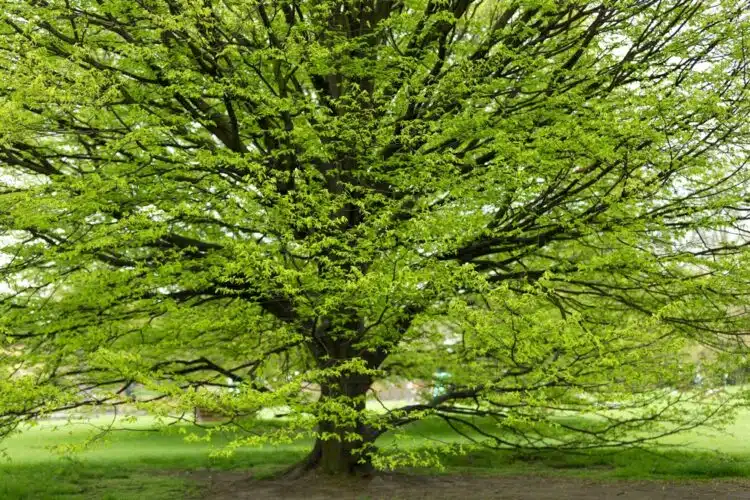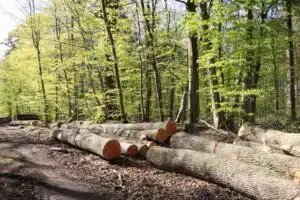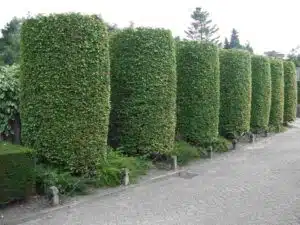HALF PRICE SALE ON EVERYTHING ENDS AT MIDNIGHT FRIDAY
NEW SEASON BARE ROOTS AT 50% OFF LAST SEASONS PRICES – ENDS 31 JULY
Menu
HALF PRICE SALE ON EVERYTHING ENDS AT MIDNIGHT FRIDAY
NEW SEASON BARE ROOTS AT 50% OFF LAST SEASONS PRICES – ENDS 31 JULY
 https://www.hopesgrovenurseries.co.uk/wp-content/uploads/2024/02/shutterstock_138218648-750x500.jpg
HORNBEAM - AS HARD AS NAILS
https://www.hopesgrovenurseries.co.uk/wp-content/uploads/2024/02/shutterstock_138218648-750x500.jpg
HORNBEAM - AS HARD AS NAILS
Hornbeam takes its common name from the wooden yokes placed over the necks of farm animals, whether ploughing or transporting crops. It’s literally the beam between the horns and the Latin name Carpinus also refers to its use as ox yokes. Wooden milk churns were also made to hold the milk and cream and the great tree man and wine expert, Hugh Johnson, refers to it as the ‘furniture of the dairy’ in his book on Trees.

Before the advent of cheap metal manufacture, it was the engineering wood of choice for cogs on windmills, mill wheels and water wheels. It was even known as ironwood. It was used for butcher’s blocks and piano hammers. Now there’s a contrast, from blood and gore to Beethoven and Greig! And, although it did get used for furniture, I imagine that it was a difficult wood to fashion into Chippendale-style finery unless you were willing to blunt or break every tool in the box. It was also used for Roman chariots, although there are only two European species of this tree. Hornbeams have the hardest wood of any European tree. There are also forty or so species found in Eastern Asia.
European hornbeam logs burnt slowly on the hearth, so they were perfect for charcoal production. Hence hornbeams, which are found growing amongst oak trees in ancient woodlands of southern Britain, were often pollarded or coppiced on a regular basis. This produced thinner, more-manageable boughs and stems. Coppicing took them down to ground level every sixteen or seventeen years, allowing the woodland flora to thrive underneath. Pollarding took the stems back to a high trunk, so the whippy growths sprang away from the trunk like flowers radiating out form a tight-necked vase. Willows got the same treatment.

Hornbeams are long-lived trees and The Woodland Trust have dated some to 350 years of age. The average is nearer 250 years, say the Trust. The Latin species name Carpinus betulis, alludes to the similar-looking beech tree. There are significant differences though. Hornbeam enjoys heavier soil and it will grow on clay, which beech trees find difficult. The beech likes drier feet and will cope with really light soil. It’s important to choose the right one for your ground.
When it comes to differences the foliage shows obvious differences. If you take the analogy of potato crisps, of which I am extraordinarily fond, hornbeam foliage has the regular furrowed texture of crinkle cut crisps, but in a child-like size, The leaf edges are highly serrated. Beech is more like a wavy-edged flat-bake crisp. They leaf up at different times. Hornbeam produces its bright-green foliage earlier than beech, so it makes a better backdrop for spring-flowering beds planted with tulips say. By the time they’re out, the hornbeam will have leafed up. Beech foliage arrives two or more weeks later. Autumn colour differs too. Beech develops orange tones year on year, but the hornbeam is more of a dull-yellow. Both keep some leaves in winter, when pruned, but hornbeam tends to lose more leaf in colder, windier gardens such as mine.

Hornbeam is faster growing than beech, putting on an average of 20-40cm per year. The trunk offers more texture than beech, perhaps it’s the ‘crinkle-cut gene’ emerging again. Beech trunks are a paler grey and smoother. Think elephant’s leg and you won’t be far off. If hornbeam is left unpruned, it produces catkins and these develop into chains of green three-winged inedible fruits. They spin round in helicopter-fashion, whereas beech mast clatters to the ground.
The great thing about hornbeam is, it doesn’t mind being pruned or lopped on a regular basis, so most gardeners restrict their accommodating hornbeams into hedges, pleached trees or trees on stilts. Perhaps the most famous hornbeam avenue is found growing at Hidcote Manor in Gloucestershire in an area known as the Stilt Garden. Although this Grade 1 garden was gifted to the National Trust in 1948, this avenue was planted by the American owner Lawrence Johnson in the 1920s or 1930s. The avenue of trees leads to an ornate gate and, as you near the end, you get views over the Vale of Evesham to the Malvern Hills beyond. Hornbeams provide good vistas.
Hidcote was the first garden-only property placed in the Trust’s care and, although much of the herbaceous planting has been lost over time, the woody structure of garden rooms remains intact. It’s often said that Johnson was inspired by Reginald Cory’s Dyffryn Garden close to Cardiff. Cory (1871-1934) famously worked with the influential garden designer Thomas Mawson (1861 – 1933). Cory and Johnson would probably have had copies of Mawson’s ‘The Art and Craft of Garden Making’ published in 1901. However, Johnson was a seasoned traveller and Hidcote Manor absorbed continental influences, from France especially.
Stilted hornbeams, forming garden allées, and geometrical designs, were often used in grand French gardens. This is the appeal of the clipped hornbeam. It offers winter structure and geometric precision. It’s possible to get an instant effect using ready-grown pleached hornbeams. These offer immediate privacy and structure.

Pruning regimes vary. A newly-planted hornbeam hedge should not have its height shortened until it has reached your desired height. Late summer is the best time, because the growth spurt will now be slowing down. It’s worth using sharp secateurs, because rough trimming with electric blades etc damages the leaves. When the hedge is at the desired height, trim the top using string to mark the levels. Try to make sure that the base of the hedge is thicker than the top, tapering the sides down to a broader base.
Twice a year pruning, in early spring and autumn, is required if you’re aiming for a narrow screen of pleached trees. You will also need to support the trees by making or buying a framework. These versatile trees can be used in a variety of ways. Cube-cut trees can be enclosed in box squares, for instance.
When buying expensive trees, you will need to prepare the ground well. Dig a hole as deep as the root mass and about twice as wide and enlist another person when planting. It’s a two-man job, as so many heavy garden tasks are! Plant the trees to the same level as they were in the pot and level up the heights. A line of string helps here.
After care is also important, especially now that spring and summer droughts arrive more often than not. Don’t dribble a hose over them, because this will encourage the roots to come to the surface. Aim to water your trees thoroughly every few days. I favour gently tipping buckets of water over newly planted woody plants. However, if you’re planting up an avenue or allée, you will have to use a hose!
It will all be worth the effort and, although your hornbeam will look glorious throughout the year, it will become spectacular in winter when low light highlights shape and texture to great effect.
Many of our customers buy topiary plants (and hedging plants) to grow in containers, one frequently asked question is how large does the pot that I plant them into need to be?
Expert horticultural advice on the merits and pitfalls of planting bare root yews, and how to get the best from them.
Pleached trees are a garden-design favourite, because they provide an instant leafy screen that looks stylish as soon as it’s planted. They offer privacy for you and they help to muffle noise and that’s becoming more important in our busy world. They provide a living screen that’s far more eco-friendly than a stark wooden fence…